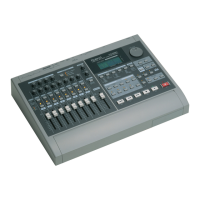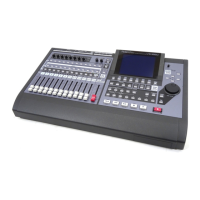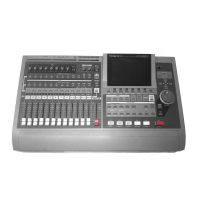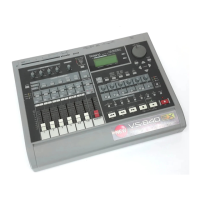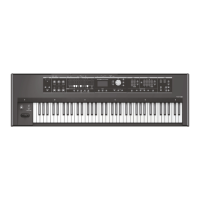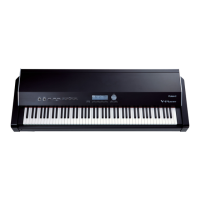39
Algorithm List
Mic Modeling (Microphone Modeling)
This modifies sound that was recorded by a conventional dynamic mic, lapel mic or direct line, causing it to sound as though it had
been recorded by an expensive condenser mic or a special studio mic. The mic simulator can add effects of proximity or distance.
fig.08-67
Parameter (full name) Setting Function
Lnk (Link): Channel B follows the settings for Channel A.
Link (Link Switch) On, Off Specifies if Channel B follows or does not follow the settings for Channel A.
CnvA, CnvB (Mic Converter): Converts the characteristics of the low-end general-purpose microphone into the characteristics of the
High-end microphone for studio application.
Sw (Switch) On, Off Turns the microphone converter on or off.
Input (Input) See the column on this page. Sets the microphone type used for recording.
Output (Output) See the column on this page. Sets the microphone types to be Modeled.
Phase (Phase) Nor, Inv Sets the microphone phase.
BCutA, BCutB (Bass Cut Filter): Cuts off undesired low frequency band sounds such as pop noise.
Sw (Switch) On, Off Turns the bass cut filter on or off.
Freq (Frequency) Thru, 20 - 2000 Hz Sets the frequency for cutting off undesired low frequency band sounds such as pop noise.
DstnA, DstnB (Distance): Models the frequency characteristics and time difference due to distance difference.
Sw (Switch) On, Off Turns the distance on or off.
Prox.Fx (Proximity Effect) -12– +12 Corrects the low frequency band characteristics due to the distance from the sound source.
Time (Time) 0–3000 cm Models the time difference due to the distance from the sound source.
LmtA, LmtB (Limiter): Prevents distortion by suppressing signals at High levels.
Sw (Switch) On, Off Turns the limiter on or off.
Thrsh (Threshold) -60–0 dB Sets the volume level to start suppressing excessive input.
Attack (Attack Time) 0–100 Sets the time from when the input level exceeds the threshold level to when the effect begins to apply.
Release (Release Time) 0–100 Sets the time from when the input level drops below the threshold level to when the effect ceases to apply.
Detect HPF Freq
(Detect HPF Frequency) Thru, 20 - 2000 Hz Normally, sets “Thru.” Sets the cutoff frequency of the level detection section.
Level (Output Level) -60– +24 dB Sets the volume of the compressor sound.
Mic Converter A
Bass Cut A Distance A Limiter A
Mic Converter B
Bass Cut B Distance B Limiter B
Link
Input A
Input B
Output A
Output B
Selecting the microphone used for recording.
Input of Mic Converter selects the type of microphone to be used recording.
DR-20: Roland DR-20 (dynamic microphone manufactured by Roland)
Sml.Dy: Small Dynamic Microphone (dynamic microphone used for instruments and vocal)
Hed.Dy: Head-worn Dynamic Microphone (headset-type dynamic microphone)
Min.Cn: Miniature Condenser Microphone (very small condenser microphone)
Flat: Line input
C3000B: AKG C3000B (Condenser microphone manufactured by AKG)
Microphone types that can be modeled
The characteristics of the low-end general-purpose microphone are converted into the characteristics of the High-end
microphone for studio application. You can add sound quality changes to already recorded sounds just as if a different type of
microphone were used or if they were recorded at a different distance. In addition, it is possible to add microphone characteristics
to line-recorded instrumental sounds. These characteristics can be set up by selecting the relevant value for Out of Mic Converter.
Sml.Dy: Dynamic microphone for general musical instruments and vocal sounds. Ideal for a guitar amplifier and snare drums.
Voc.Dy: Dynamic microphone for standard vocal sounds. Characterized in middle frequency band sounds with tension. Suited for vocal.
Lrg.Dy: Dynamic microphone with a extended low frequency band. For bass and tom drums.
Sml.Cn: Small condenser microphone for musical instruments. Characterized in bright High frequency band sounds. For metal percussion
and acoustic guitars.
Lrg.Cn: Condenser microphone with flat characteristics. For vocal, narration and live musical instruments.
Vnt.Cn: Vintage condenser microphone. For vocal and live musical instruments.
Flat: Microphone with flat frequency response. For removing peculiarity of the microphone used for recording sounds.
* When a condenser-type mic is selected in OUT, low-range noise transmitted through the mic stand may be accentuated due to the mic’s low range
characteristics. In such instances, either cut out any unnecessary low end with bass cut filter, or equip the mic stand with an isolation mount (a mic
holder with rubber or other shock absorbing material).
* The “Lrg.Dy” and the “Lrg.Cn” of the Out parameter are valid only if the In parameter is set to “Min.Cn.”
Proximity effect of microphone
In nature, a microphone tends to extend the low frequency band characteristics when placed close to the sound source. This
is called proximity effect. This effect can be modeled in Proximity Effect (Prox-Efect). Set the parameter to a positive (+) value
for a shorter distance to the sound source and a negative (-) value for a longer distance to the sound source. Time of Distance
models the time difference due to distance from the sound source.
Controlling Channels A and B separately
Setting Link On enables simultaneous control on the 4-Band Parametric Equalizer via Channel B according to the settings on
the Channel A side. To control Channels A and B separately, turn Link Off.
VS-2000_e.book 39 ページ 2005年12月12日 月曜日 午後4時54分

